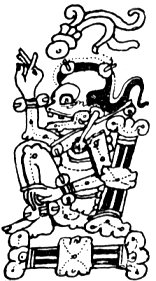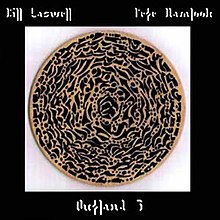시진
Cizin| 시진 | |
|---|---|
죽음의 신 | |
 | |
| 기타 이름 | 키신, 아푸치, 시발바,[1] 염치밀,[2] 훈하우,[3] 아푸차, 아우푸치, 쿰하우, 어푸코, 후아우, 츠옹테목,[4] 아흐알푸치.[5] |
시진은 마야의 죽음과 지진의 신이었다.[1]그는 마야 문화에서 가장 중요한 마야 죽음의 신이다.[6]학자들은 그를 신 A라고 부른다.[7]
유카탄 마야에게 그는 훈-카메와 부쿠브-카메였다.[5][clarification needed]그는 또한 Mictlántēcutli와 비슷한 점이 있다.[8]
이름과 어원
신 시진은 키젠, 욤 시밀,[9] 키신, 아 푸치, 시발바,[1][10] 염 시밀,[2] 훈하우,[11] 아 푸차, 오 푸치, 컴 하우, 어푸코, 후아우, 톤테모크,[12] 아푸치, 아할 푸치와 같은 여러 이름으로 통한다.[5]그는 가끔 기미라고 불렸다.[13]마야인들은 오늘 그를 염씨 또는 염씨밀이라고 부른다.[5]
시진 개연성이라는 이름은 악취를 의미한다.[14]시진은 편평함을 의미하는 뿌리 "ciz"에서 유래한다.[15]그의 이름은 '냄새나는 원'을 의미한다고 한다.[1][clarification needed]
염치밀은 죽음의 영주를 의미하고 훈아우는 하나의 통치자를 의미한다.[16]아 푸치는 녹는다는 뜻이다.[5]
신화
그는 노호차겸의 형으로 여겨진다.[17]그는 바카브족을 죽였다고 한다.[18]
라칸돈 신화에 따르면 사람이 죽으면 시진은 그의 입과 항문에 영혼을 태운다.영혼이 불평할 때, 시진은 영혼을 찬물에 담그게 하고, 영혼은 영혼이 무로 분해될 때까지 그것들을 불태우도록 이끌었던 시진에게 더 많은 불평을 하게 한다.[19][8]
대중문화에서
시진은 2014년 무료 멀티플레이어 온라인 배틀 아레나 비디오 게임 스마이트에서 아 푸치라는 이름으로 마야 판테온의 일부로 플레이 가능한 신으로 등장한다.[20]
참조
- ^ a b c d "Cizin Mayan god". Encyclopedia Britannica. Retrieved 2020-10-05.
- ^ a b Read, Kay Almere; Gonzalez, Jason J. (2002-06-13). Mesoamerican Mythology: A Guide to the Gods, Heroes, Rituals, and Beliefs of Mexico and Central America. OUP USA. p. 149. ISBN 978-0-19-514909-8.
- ^ Quick, P. S. (2015-11-17). All About: Mysterious Maya. Andrews UK Limited. ISBN 978-1-78538-320-5.
- ^ Abel, Ernest L. (2009-03-20). Death Gods: An Encyclopedia of the Rulers, Evil Spirits, and Geographies of the Dead. ABC-CLIO. p. 9. ISBN 978-0-313-35713-8.
- ^ a b c d e Bingham, Ann; Roberts, Jeremy (2010). South and Meso-American Mythology A to Z. Infobase Publishing. p. 3. ISBN 978-1-4381-2958-7.
- ^ Jordan, Michael (2014-05-14). Dictionary of Gods and Goddesses. Infobase Publishing. p. 67. ISBN 978-1-4381-0985-5.
- ^ Witschey, Walter Robert Thurmond; Brown, Clifford T. (2012). Historical Dictionary of Mesoamerica. Scarecrow Press. p. 90. ISBN 978-0-8108-7167-0.
- ^ a b Read, Kay Almere; Gonzalez, Jason J. (2002-06-13). Mesoamerican Mythology: A Guide to the Gods, Heroes, Rituals, and Beliefs of Mexico and Central America. OUP USA. p. 149. ISBN 978-0-19-514909-8.
- ^ "The Mayan Pantheon: The Many Gods of the Maya". World History Encyclopedia. Retrieved 2021-10-07.
- ^ Willey, Gordon R. (1965-01-01). Handbook of Middle American Indians, Volumes 2 and 3: Archaeology of Southern Mesoamerica. University of Texas Press. p. 674. ISBN 978-1-4773-0655-0.
- ^ Quick, P. S. (2015-11-17). All About: Mysterious Maya. Andrews UK Limited. ISBN 978-1-78538-320-5.
- ^ Abel, Ernest L. (2009-03-20). Death Gods: An Encyclopedia of the Rulers, Evil Spirits, and Geographies of the Dead. ABC-CLIO. p. 9. ISBN 978-0-313-35713-8.
- ^ Mahoney, Emily (2017-12-15). The Mysterious Maya Civilization. Greenhaven Publishing LLC. p. 85. ISBN 978-1-5345-6185-4.
- ^ Kampen, Michael Edwin (1981). The Religion of the Maya. BRILL. p. 7. ISBN 978-90-04-06400-3.
- ^ Taube, Karl A.; Taube, Professor of Anthropology Karl A. (1992). The Major Gods of Ancient Yucatan. Dumbarton Oaks. p. 14. ISBN 978-0-88402-204-6.
- ^ Faiella, Graham (2005). Mesoamerican Mythology. The Rosen Publishing Group. p. 36. ISBN 978-1-4042-0772-1.
- ^ "The Mayan Pantheon: The Many Gods of the Maya". World History Encyclopedia. Retrieved 2021-09-11.
- ^ Coulter, Charles Russell; Turner, Patricia (2013-07-04). Encyclopedia of Ancient Deities. Routledge. p. 28. ISBN 978-1-135-96390-3.
- ^ Thompson, John Eric Sidney (1990). Maya History and Religion. University of Oklahoma Press. p. 303. ISBN 978-0-8061-2247-2.
- ^ www.smitegame.com https://www.smitegame.com/gods/ah-puch. Retrieved 2021-09-11.
{{cite web}}:누락 또는 비어 있음title=(도움말)


